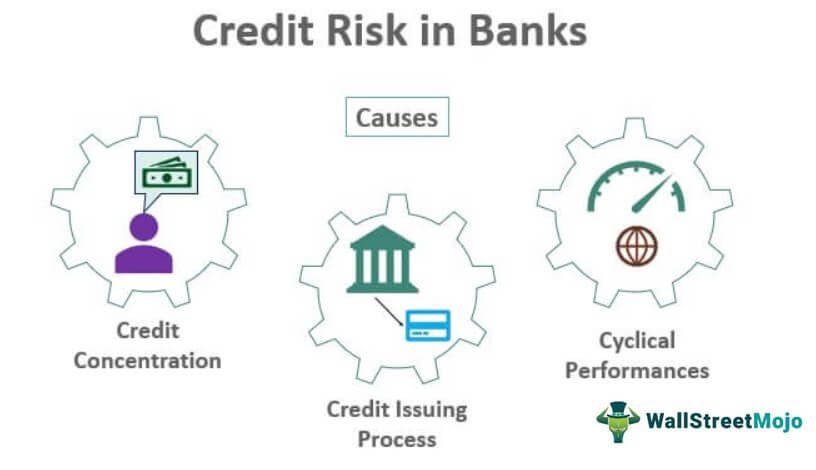Credit risk in banking refers to the potential loss that a financial institution may face if a borrower fails to repay its debt or fulfill its financial obligations. In simpler terms, it is the risk of borrowers defaulting on their loans. Understanding and managing credit risk is crucial for banks to maintain their financial stability and protect their stakeholders. This article will delve into the intricacies of credit risk in banking, its impact on the economy, and the strategies employed by banks to mitigate this risk. So, let’s dive deeper into what is credit risk in banking and why it is of utmost importance for the financial sector.
What is Credit Risk in Banking?
When it comes to banking, credit risk is a crucial factor that needs to be assessed and managed effectively. In simple terms, credit risk refers to the potential loss a bank may face if a borrower or counterparty fails to fulfill their financial obligations. It is the risk of default on a loan or the non-payment of any other form of credit, leading to financial loss for the lender or investor.
Banks and financial institutions are heavily dependent on lending money to individuals, businesses, and governments. These loans play a vital role in stimulating economic growth and generating revenue for the banks themselves. However, with these loans comes the inherent risk of borrowers defaulting on their payments.
Even though credit risk is a natural part of the banking industry, it can pose significant challenges if not managed effectively. In order to mitigate this risk, banks employ various strategies and measures to evaluate the creditworthiness of borrowers and mitigate potential losses.
The Importance of Credit Risk Management
Credit risk management is an essential aspect of banking operations. It involves identifying, assessing, and monitoring credit risks to ensure that banks can make informed lending decisions and protect themselves from financial losses. Here are some key reasons why effective credit risk management is crucial:
- Protecting the lender: By assessing credit risk, banks can identify potential defaulters and adjust their lending terms accordingly. This helps protect the lender from financial losses.
- Maintaining regulatory compliance: Banks are subject to various regulations and guidelines that require them to manage credit risk effectively. Failure to comply with these regulations can result in penalties and damage to the bank’s reputation.
- Maintaining financial stability: Proper credit risk management ensures the stability of a bank’s financial position by minimizing the chances of unexpected losses due to defaults.
Types of Credit Risk
Credit risk can take different forms, depending on the nature of the borrower and the specific circumstances. Here are some common types of credit risks prevalent in the banking industry:
- Default Risk: This is the risk that a borrower will completely fail to repay their debt obligation, resulting in a total loss for the lender.
- Concentration Risk: Concentration risk arises when a large portion of a bank’s credit exposure is concentrated in a specific industry, geographic region, or individual borrower. If that industry or region faces financial difficulties, the bank is at a higher risk of sustaining significant losses.
- Counterparty Risk: Counterparty risk emerges when a bank enters into financial contracts with external parties. The risk here is that the counterparty may default on their obligations, leading to financial loss for the bank.
- Country Risk: Country risk refers to the risk associated with lending to borrowers in foreign countries. Factors such as political instability, economic conditions, and regulatory frameworks can significantly impact a borrower’s ability to repay their debts.
Managing Credit Risk
Managing credit risk effectively is crucial for the long-term success of banks. Here are some key strategies employed by banks to mitigate credit risk:
- Credit Scoring: Banks use credit scoring models to assess the creditworthiness of borrowers. These models consider various factors such as credit history, income level, and existing debts to determine the likelihood of default.
- Collateral: Requiring borrowers to provide collateral, such as property or assets, can help mitigate credit risk. In the event of default, the bank can seize and liquidate the collateral to recover the outstanding loan amount.
- Diversification: By diversifying their loan portfolios across different industries, geographic regions, and borrower types, banks can reduce the impact of potential defaults in a specific sector or region.
- Credit Limits and Risk Appetite: Banks set credit limits for borrowers based on their risk appetite and the borrower’s creditworthiness. This helps ensure that the exposure to any one borrower is within acceptable limits.
- Monitoring and Early Warning Systems: Banks continuously monitor the financial health and repayment behavior of borrowers to identify early warning signs of potential default. This allows them to take proactive measures to mitigate credit risk.
- Insurance and Risk Transfer: Banks may use credit insurance or enter into risk transfer arrangements, such as credit derivatives, to shift a portion of the credit risk to external parties.
Credit risk is an inherent part of the banking industry, and effective management of this risk is crucial for the stability and success of banks. By employing various strategies and measures, banks can assess creditworthiness, mitigate potential losses, and make informed lending decisions. Understanding the different types of credit risk and implementing sound credit risk management practices allows banks to navigate the complex landscape of lending while safeguarding their financial interests.
Credit Risk Explained
Frequently Asked Questions
Frequently Asked Questions (FAQs)
What is credit risk in banking?
Credit risk in banking refers to the potential for borrowers to default on their loans or fail to fulfill their obligations to repay the borrowed funds. It is the risk that banks and other financial institutions face when lending money to individuals, businesses, or governments.
How is credit risk assessed in banking?
Banks assess credit risk by analyzing various factors such as the borrower’s credit history, financial stability, collateral, and repayment capacity. They may also consider industry-specific risks and economic conditions that could impact the borrower’s ability to repay the loan.
Why is credit risk important for banks?
Credit risk is of significant importance for banks because it directly affects their financial stability and profitability. When borrowers default, banks may face losses on their loan portfolios, which can impact their liquidity and capital adequacy. Managing credit risk is crucial for maintaining a healthy banking system.
What are the types of credit risk in banking?
The types of credit risk in banking include:
1. Default risk: The risk that a borrower fails to repay the loan.
2. Counterparty risk: The risk that the other party in a financial transaction may default on their obligations.
3. Concentration risk: The risk of a large proportion of loans being exposed to a specific borrower, industry, or geographic location.
4. Sovereign risk: The risk associated with lending to foreign governments or government-related entities.
How do banks mitigate credit risk?
Banks employ various risk mitigation strategies to manage credit risk, including:
1. Implementing robust credit assessment and underwriting procedures.
2. Diversifying loan portfolios to reduce concentration risk.
3. Requiring collateral or guarantees to secure loans.
4. Setting appropriate credit limits based on borrower risk profiles.
5. Regularly monitoring and reviewing borrowers’ financial performance.
6. Using credit derivatives and insurance to hedge against credit risk.
How does credit risk impact interest rates?
Credit risk affects interest rates as banks incorporate the level of risk associated with a borrower into the pricing of loans. Higher credit risk borrowers are typically charged higher interest rates to compensate for the increased likelihood of default. Conversely, lower credit risk borrowers may receive lower interest rates.
Can banks eliminate credit risk entirely?
It is not possible for banks to completely eliminate credit risk. Lending inherently involves a certain level of risk. However, banks can manage and mitigate credit risk through prudent lending practices, rigorous risk assessment, and ongoing monitoring of borrowers’ creditworthiness.
What are the consequences of ineffective credit risk management?
Ineffective credit risk management can have severe consequences for banks, including:
1. Increased loan defaults and losses.
2. Negative impact on profitability and capital adequacy.
3. Strain on liquidity, as funds tied up in non-performing loans cannot be utilized for further lending.
4. Damage to the bank’s reputation and customer confidence.
5. Regulatory scrutiny and potential penalties for non-compliance.
Final Thoughts
Credit risk in banking refers to the potential loss that a financial institution may incur due to a borrower’s failure to repay a loan or meet their financial obligations. It is a critical factor that banks and other lending institutions must carefully assess and manage to maintain financial stability. By evaluating the creditworthiness of borrowers, analyzing their financial profiles, and implementing risk mitigation strategies, banks can minimize the likelihood of defaults and non-performing loans. Effective credit risk management involves ongoing monitoring, prudent lending practices, and diversification of loan portfolios. Thus, understanding and effectively managing credit risk in banking is crucial for the stability and success of financial institutions.



